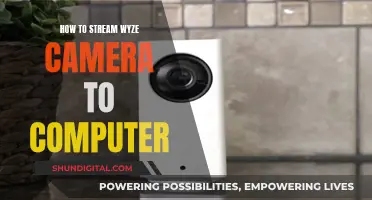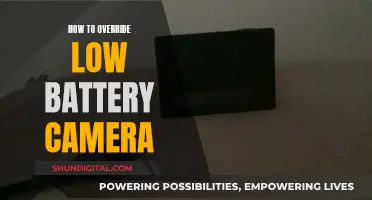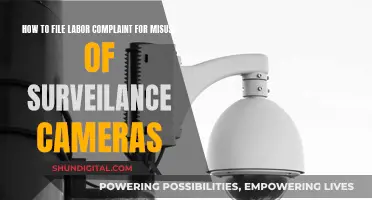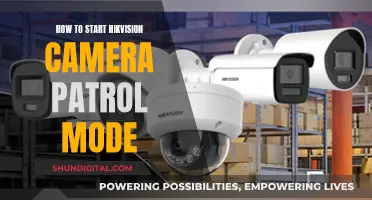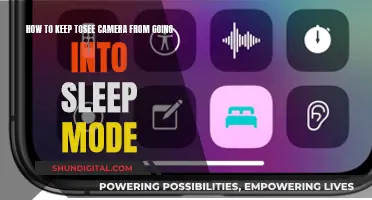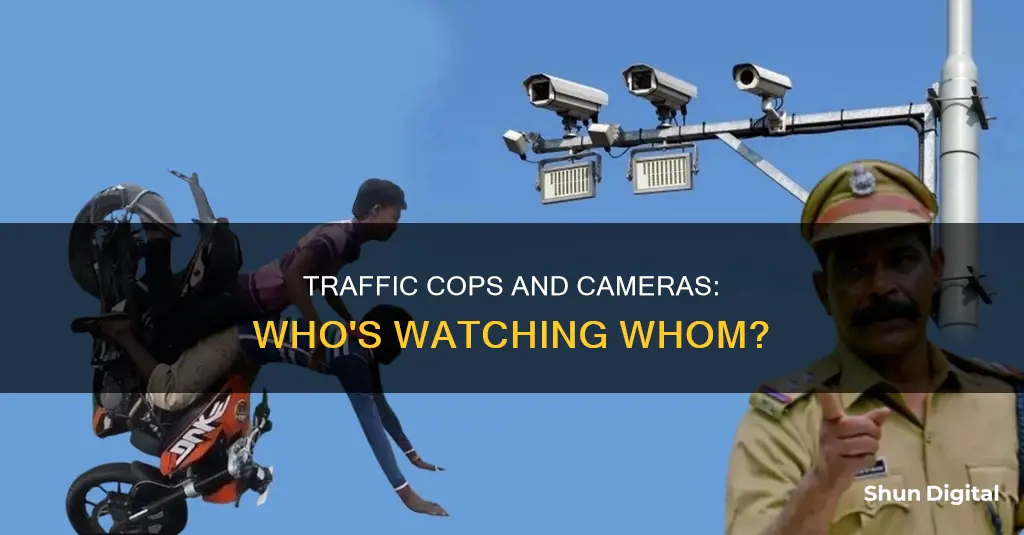
Traffic cops often have cameras in their vehicles, which are typically turned on while driving to capture crucial events and incidents. These cameras can be mounted on the trunks or roofs of police cars and are used for an automatic license plate reader (ALPR) system. They can also be installed on the dashboard, facing out through the front windshield, or at the back of the car. The cameras are useful for enforcing traffic laws, such as detecting speeding, red-light running, and other traffic violations. While the use of traffic cameras by law enforcement is common, it is not universally accepted and raises concerns about public safety, privacy, and drivers' rights.
| Characteristics | Values |
|---|---|
| Purpose | To detect and enforce motoring offences, including speeding, red light violations, toll booth evasion, unauthorised use of bus lanes, and congestion charge violations. |
| Installation | Mounted beside or over a road or installed in an enforcement vehicle. |
| Functionality | May be linked to an automated ticketing system. |
| Effectiveness | Studies show a reduction in crashes, injury crashes, and fatalities or severe injuries. |
| Privacy Concerns | May enable mass surveillance of vehicle movements and raise privacy concerns. |
| Legality | The use of traffic cameras varies by state, with some states banning or limiting their use while others permitting them statewide. |
What You'll Learn
- Traffic cops use cameras to detect and prevent crimes, such as kidnapping and robbery
- Cameras are used to capture violations and license plate numbers
- The use of traffic cameras is controversial, raising questions about privacy and drivers' rights
- Traffic cameras can be used to issue speeding tickets
- The use of traffic cameras varies by state

Traffic cops use cameras to detect and prevent crimes, such as kidnapping and robbery
Traffic cops use cameras for a variety of purposes, including crime detection and prevention. While the use of traffic cameras by law enforcement is a controversial topic, they can be an effective tool for improving road safety and reducing accidents and injuries.
One of the primary ways that traffic cops use cameras to detect and prevent crimes is through the use of automatic license plate reader (ALPR) systems. These systems involve cameras that scan and capture images of license plates, which are then checked against local, state, and federal databases to identify vehicles of interest. This technology can be used to quickly locate vehicles suspected in crimes such as kidnapping or robbery, as well as to identify vehicles with registration issues or those associated with individuals who have a suspended driver's license. ALPR systems have proven to be effective in catching criminals and locating missing persons, making them a valuable tool for law enforcement.
In addition to ALPR systems, traffic cops also use cameras for speed limit enforcement and red-light enforcement. These types of cameras are typically mounted beside or over a road or installed in enforcement vehicles to detect speeding, vehicles running red lights, or other motoring offenses. While the use of these cameras for traffic enforcement is also controversial, studies have shown that they can be effective in reducing accidents and injuries. For example, a worldwide review of studies found that speed cameras led to a reduction of "11% to 44% for fatal and serious injury crashes."
The use of traffic cameras by law enforcement raises important questions about privacy and drivers' rights. Some people argue that the use of these cameras amounts to "Big Brother tactics" and that they are more about revenue generation than improving road safety. Additionally, the use of automated systems can lead to errors and false accusations, as seen in cases where speed cameras produced erroneous readings or clocked vehicles travelling at speeds they were not.
To address these concerns, states have implemented different regulations regarding the use of traffic cameras. Some states ban automated traffic cameras altogether, while others limit how and where law enforcement can use them. Some states also require that signs must be posted to warn drivers when cameras are active. It is important for drivers to understand their local laws and regulations regarding the use of traffic cameras to know their rights and how to appeal any potential violations.
Understanding Camera Image Modes: What's the Difference?
You may want to see also

Cameras are used to capture violations and license plate numbers
Traffic cameras are used to capture violations and vehicles' license plate numbers. These cameras are typically mounted on street poles, streetlights, highway overpasses, mobile trailers, or attached to police cars. They can also be installed beside or over a road or inside an enforcement vehicle.
The cameras capture images of license plates, along with the location, date, and time. This data is then uploaded to a central server, where it can be accessed by law enforcement agencies. The data can be used to identify vehicles that have been involved in crimes, track the movement of vehicles, and enforce traffic laws.
In some cases, the cameras may also capture images of the vehicle's driver and passengers. This has raised concerns about privacy and the potential for mass surveillance. However, supporters argue that these cameras improve road safety and reduce accidents and injuries.
The use of traffic cameras varies by state and jurisdiction. Some states ban automated traffic cameras, while others allow local governments to set up their own camera programs. The data collected by these cameras can be stored for extended periods, sometimes for several years.
Car Cameras in Wisconsin: Are They Legal?
You may want to see also

The use of traffic cameras is controversial, raising questions about privacy and drivers' rights
The use of traffic cameras is a highly controversial topic, with critics raising questions about privacy and drivers' rights. While some states and municipalities have embraced the technology as a means to improve road safety and reduce accidents, others have raised concerns about the potential for abuse and the infringement of civil liberties.
One of the main concerns surrounding traffic cameras is the issue of privacy. With the majority of these systems, a video feed is running constantly, capturing all drivers, not just those breaking traffic laws. This constant surveillance has been viewed by many as an invasion of privacy and a potential violation of civil liberties. There is also the concern that the data collected by these cameras will be used for purposes beyond tracking reckless drivers, such as government or private industry surveillance.
Another issue that has been raised is the question of due process and fairness. In some cases, the tickets generated by these systems are sent to the owner of the vehicle, regardless of who was driving at the time of the alleged violation. This can place the burden of proof on the owner to prove that they were not the one driving, which goes against the principle of innocent until proven guilty. Additionally, there have been cases where private companies that operate the camera programs are incentivized to issue more tickets, leading to public cynicism and suspicion.
The use of traffic cameras has also been criticized for the potential to infringe on constitutional rights. In some states, such as Texas and Utah, the use of red light and speeding traffic enforcement cameras is prohibited. Critics argue that the use of these cameras is an overreach of government authority and a privatization of law enforcement. There are also concerns about the lack of oversight and the potential for errors in the ticketing process.
Proponents of traffic cameras argue that they are an effective tool for improving road safety and reducing accidents. Studies have shown that the presence of traffic cameras can lead to a significant reduction in speeding and red-light violations, resulting in fewer accidents and injuries. Additionally, in today's world, when public safety is a top priority, the use of these cameras can be crucial in quickly locating vehicles involved in criminal activities, such as kidnappings or robberies.
The controversy surrounding traffic cameras highlights the delicate balance between public safety and individual privacy and rights. While the technology can be a valuable tool for law enforcement, it is essential to address the concerns raised by critics to ensure that the use of traffic cameras is fair, transparent, and respectful of civil liberties.
Mastering Camera Raw Color Correction Techniques
You may want to see also

Traffic cameras can be used to issue speeding tickets
The use of traffic cameras for speeding tickets has been a controversial topic, raising questions about public safety, privacy, and drivers' rights. Some people argue that these cameras improve road safety by deterring speeding, while others view them as a form of "Big Brother" surveillance and revenue-raising for local governments.
The process of receiving a speeding ticket from a traffic camera varies slightly by jurisdiction. Typically, an officer or another authorised person reviews the photos or video footage to verify the violation before issuing a citation. The registered owner of the vehicle then receives the ticket by mail and has the option to pay the fine or contest the citation. In some states, camera-issued tickets do not result in traffic violation demerit points, whereas officer-issued tickets for the same violation do.
It is worth noting that the legality of speed cameras has been contested by attorneys, and court decisions and statutes vary by jurisdiction. While some courts have found automated citations to be unconstitutional, most courts have upheld the use of red light and speed cameras, concluding that they do not violate the constitutional rights of drivers.
To avoid speeding tickets from traffic cameras, drivers may resort to various tactics such as braking before reaching the camera or using GPS devices that alert them to camera locations. However, some of these practices, such as tampering with license plates or using radar jammers, are illegal in many jurisdictions.
Traffic Camera Tickets: Payment Deadline and Consequences
You may want to see also

The use of traffic cameras varies by state
In some states, the use of traffic cameras is permitted statewide for speed and red-light enforcement, while others leave it up to local governments to decide whether to implement camera programs within their jurisdiction. Additionally, some states have no specific laws regarding the use of traffic cameras, leaving it up to local law enforcement to determine how and where to use them.
The controversy surrounding automated enforcement through cameras has raised questions about public safety, privacy, and drivers' rights. While some argue that traffic cameras improve road safety and help reduce accidents and injuries, others view them as an invasion of privacy and a revenue-generating tool for local governments rather than a genuine safety measure.
It is worth noting that the laws regarding traffic cameras are subject to change, and individual states may pass new legislation or make rulings that affect the use of these cameras. As such, it is essential to stay informed about the specific laws and regulations in your state regarding the use of traffic cameras for enforcement purposes.
Switching Camera Modes: Galaxy S7 Tips
You may want to see also
Frequently asked questions
Yes, traffic cops often have cameras installed in their cars, which are typically turned on while driving. These cameras can record video and capture images of license plates, which can be used as evidence in court.
Cameras in police cars can help record events and incidents in real time, providing clarity and reducing controversy around situations. They can also be used to identify offenders and establish offenses, such as running a stop sign or speeding. Additionally, they can aid in locating vehicles suspected in crimes such as kidnapping or robbery.
The use of cameras for automated traffic enforcement has raised questions about public safety, privacy, and drivers' rights. Some states have banned or restricted the use of traffic cameras, while others require additional forms of identification, such as the presence of a police officer, to issue tickets based on camera evidence. There may also be limitations on the range and accuracy of the cameras, and in some cases, private citizen footage may not be sufficient for issuing speeding tickets.


